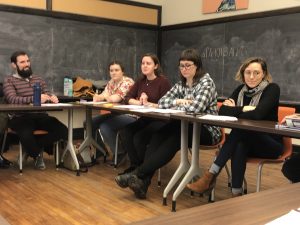15 Activity 4.1 Tracing Toxic Heritage Narratives
Audrey Ricke and Elizabeth Kryder-Reid

Associated Readings:
Section 4: Kryder-Reid_May_Section4_NarratviesToxicHeritage_Introduction
Chapter 10, Loretta Lou, “Preservation by Demolition: Toxic Heritage in Contemporary China”
Chapter 13, Elizabeth Kryder-Reid, Owen Dwyer, and Gabriel Filippelli, “Dirty Laundry: The Toxic Heritage of Dry Cleaning in Indianapolis, Indiana.”
Chapter 14, Arthur McIvor, “Toxic City: Industrial Residues, the Body and Community Activism as Heritage Practice in Glasgow.”
Case Study 7, Matteo Benussi, “Three Memory Frameworks on Chernobyl”
Targeted Skills:
Analysis, Digital Literacy, Library Research, Archival Research, Field Research-Interviewing, and Reflection
Suggested Format:
Consider structuring as an individual semester-long project in an upper-division or graduate-level course. Set due dates for different deliverables or steps/sources of data in the research and analysis.
Directions:
The goal of this activity is to analyze the discourse and silences surrounding toxic heritage. Investigate what toxic impacts your community faces. There may be multiple but only certain ones receive attention in public media. Select one or two to follow or as a class divide them up among different individuals or groups. We will be focusing on the sources and narratives/silences about that environmental harm. As you trace the narratives associated with your selected toxic heritage, note: Where are the stories recorded? Whose voices are included? What perspectives are privileged?
To find data for your project,
- Explore resources at local public and university libraries.
- If you have local archives or historical societies, ask for any archival research about issues of environmental degradation in your community.
- Search local media (newspaper, TV, podcasts, radio) for stories about local issues and environmental advocacy efforts.
- Explore resources through governmental environmental agencies (eg. Environmental Protection agency, state or other more local agencies).
- Where possible, visit with elders, people of different generations, local business owners, and people involved in environmental advocacy organizations to find out about the history.
- Not sure where to get started on your local toxic heritage research? See the appendix for a sample list.
Analysis:
- How do the different sources tell the stories of toxic heritage? Is there a desire for certain parts of the history to be more widely known? Which ones? why or why not? Where is the history told (local news? industry documents? academic sources? governmental agencies? documentaries? museums?
- If paired with Chapter 10: to what extent is Loretta Lou’s “art of unnoticing” functioning as a coping strategy in this context? For whom and why?
- If paired with Chapter 13: in what ways, if any, do the histories you collected and found indicate that “environmental or ecological amnesia” may be present? For whom and why? Are there “hidden archives” where stories circulate outside of formal heritage institutions and public memory practices?
- If paired with Chapter 14: to what extent is Steven High’s “forced forgetting” (p.252) functioning within this context?
- If paired with Case Study 7, are there different memory practices in your community that reflect the variety and scales of relationship to specific sites, such as those Benussi identifies in his research at Chernobyl?
- What did this research reveal about public memory practices in your community? What stories are commonly and openly shared?
Reflection:
- How did your research influence your perception of media and how to consume it? What information outlets might you seek out more given this experience?
- Did your research spur any thoughts on activism and how heritage tools and practices might be useful in addressing the current ecological crisis? If so, what ideas came to mind?
- Did your research raise any questions or spark curiosity about getting involved in environmental activism and/or exploring a career in museums or other heritage organizations? If so, take this interest to the next level by finding out how you might get involved. Set one goal for involvement that you plan to do within the next month.

